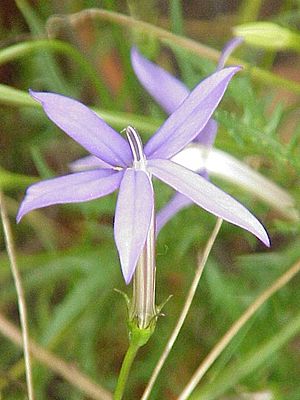Rock isotome facts for kids
Quick facts for kids Rock isotome |
|
|---|---|
 |
|
| Scientific classification | |
| Genus: |
Isotoma
|
| Species: |
axillaris
|
| Synonyms | |
|
Laurentia axillaris, Solenopsis axillaris |
|
Isotoma axillaris, also known as rock isotome or showy isotome, is a small plant that lives for more than two years. It belongs to the Campanulaceae family. This plant usually has beautiful blue or purple star-shaped flowers. You can see these flowers from September to May. People sometimes call it blue star, star flower, or laurentia.
Contents
What Does the Showy Isotome Look Like?
Isotoma axillaris is a plant that grows upright. It can reach up to 50 centimeters (about 20 inches) tall. Its stems often have a purplish color. They start with soft, short hairs but soon become smooth.
The leaves are usually between 1.5 and 15 centimeters (about 0.6 to 6 inches) long. They are narrow, about 0.5 to 5 millimeters (0.02 to 0.2 inches) wide. The leaves have deep, jagged edges with sharp points.
The flowers are single and grow where the leaves meet the stem. They are usually blue or purple. Sometimes, they can be white or pink. The center of the flower might be white, greenish, or yellow.
Each flower has five petals that join to a long tube. This tube is about 15 to 35 millimeters (0.6 to 1.4 inches) long. The petals are shaped like an oval or rectangle. They are 8 to 18 millimeters (0.3 to 0.7 inches) long. Since the petals are not joined at the ends, they form a pretty star shape. After the flower, a seed capsule grows, which is about 7 to 8 millimeters (0.3 inches) long. This plant usually flowers from September to May in its natural home.
How Did the Showy Isotome Get Its Name?
The plant Isotoma axillaris was first officially described in 1826. A botanist named John Lindley gave it its scientific name. He wrote about it in a book called Edward's Botanical Register.
The first part of its name, Isotoma, comes from ancient Greek words. Isos means "equal" or "like." Tomos means "a part." The second part, axillaris, is a Latin word. It means "of an axil." This refers to how the flowers grow from the axil, which is the angle between a leaf and the stem.
Where Does the Showy Isotome Grow?
The showy isotome plant grows naturally in parts of Australia. You can find it in Queensland, New South Wales, and Victoria. It often grows in damp cracks in rocky areas.
Growing Showy Isotome in Your Garden
Many people like to grow I. axillaris in their gardens. It can survive cold winters down to about -1 degree Celsius (30 degrees Fahrenheit). This means it's good for places with mild winters.
If you live in a much colder area, you can still grow it. You might grow it as an annual plant, which means it lives for only one year. Or, you can bring it inside during the winter to protect it from the cold.
Images for kids





